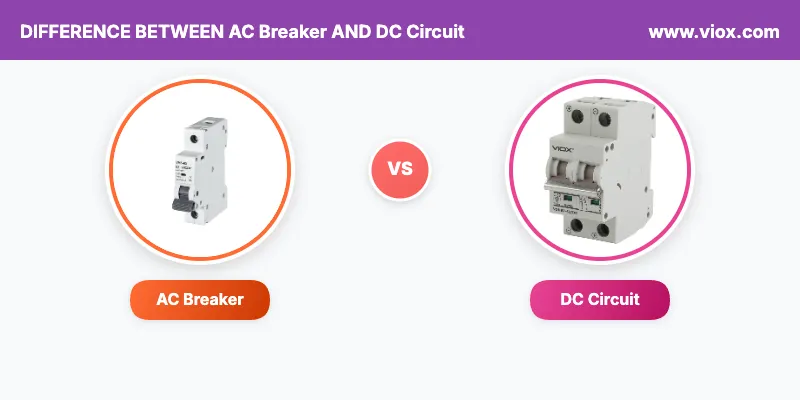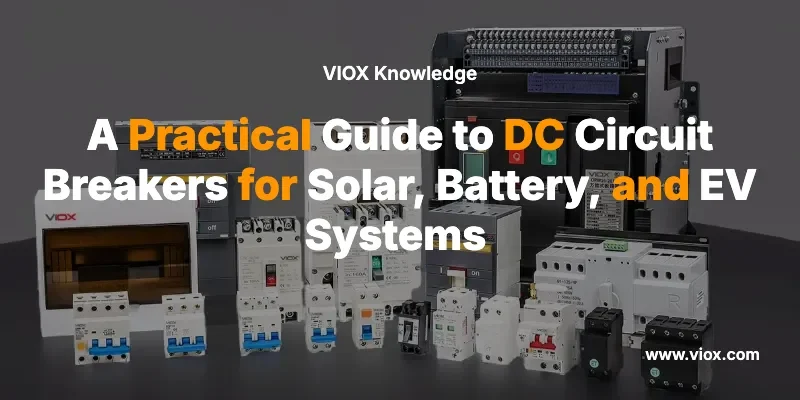This guide is for professional engineers, system designers, and advanced technicians working with modern DC power systems. It answers critical questions about how to select, install, and maintain the right DC circuit breaker to protect high-value assets like solar panel arrays, battery energy storage systems (BESS), and electric vehicle (EV) charging stations.
Why Can’t I Use an AC Breaker for a DC Circuit?

A common but dangerous mistake is using a standard AC circuit breaker in a DC application to save costs. This should never be done. The fundamental difference lies in how they handle an electrical arc—the dangerous surge of energy that forms when a circuit is interrupted.
AC Breakers Rely on Zero-Crossing: Alternating Current (AC) naturally reverses direction, hitting zero volts 120 times per second. An AC breaker is designed to open its contacts and wait for this natural “off” moment to safely extinguish the arc.
DC Breakers Must Fight the Arc: Direct Current (DC) flows continuously without a zero-crossing point. A DC breaker can’t wait for the power to stop; it must actively and forcefully kill the arc. This requires a more robust and complex design, often including specialized components like magnetic blowout coils and arc chutes.
Using an AC breaker in a DC system can lead to the breaker melting, failing to stop a fault, and causing a catastrophic fire. DC-rated breakers are specifically engineered for this challenge and are a non-negotiable safety requirement.
How to Select the Right Type of DC Circuit Breaker
Choosing the correct DC breaker involves understanding its physical construction, how it detects faults, and its performance characteristics.
Classification by Physical Size and Strength
- Miniature Circuit Breakers (DC MCB): Best for protecting individual, lower-power circuits.
- Use Cases: Protecting a single string of solar panels, DC lighting circuits, or control panels in telecommunications.
- Hodnocení: Typically up to 125A.
- Jističe s lisovaným pouzdrem (DC MCCB): Larger and more robust, used for protecting main circuits or equipment feeders.
- Use Cases: Main protection for a large residential solar array, a commercial battery storage system, or industrial machinery.
- Hodnocení: 15A to 2500A, often with adjustable trip settings for better system coordination.
- Low-Voltage Power/Air Circuit Breakers (ACB): The largest class of breakers, designed for main switchgear in major installations.
- Use Cases: Main incoming protection for a utility-scale solar farm, a large data center, or an entire industrial facility.
- Hodnocení: 800A to over 6300A, with advanced electronic trip units and communication features.
What is a Trip Curve and Which One Do I Need?
A trip curve defines how sensitive a breaker is to overcurrents. Choosing the right one prevents nuisance tripping while ensuring protection. The most common types defined by the IEC are:
| Typ MCB | Trip Current (Magnetic) | Nejlepší pro | Běžné aplikace |
|---|---|---|---|
| Typ B | 3 to 5 times rated current (In) | Circuits with low or no inrush current. | Resistive loads, residential lighting. |
| Typ C | 5 to 10 times rated current (In) | Circuits with moderate inrush current. | General purpose loads, commercial lighting, motors. This is the most common, versatile choice. |
| Typ D | 10 to 20 times rated current (In) | Circuits with very high inrush current. | Large motors, transformers, welding equipment. |
| Typ Z | 2 to 3 times rated current (In) | Protecting highly sensitive devices from low-level short circuits. | Semiconductor protection, sensitive electronic circuits. |
Critical Sizing Calculations for Real-World Applications
How to Size a Breaker for a Solar PV System

Sizing overcurrent protection for solar panels is governed by the National Electrical Code (NEC). The key is the “1.56 Rule,” which accounts for continuous operation and potential power surges.
Here’s how to calculate the breaker size for a PV source circuit:
- Find the panel’s Short Circuit Current (Isc) from its datasheet.
- Multiply the Isc by 1.56. This factor combines two NEC requirements: a 1.25 multiplier for continuous duty and another 1.25 multiplier for the “edge-of-cloud” effect, a predictable current spike.
- Calculation: Required OCPD Rating = Isc × 1.25 × 1.25 = Isc × 1.56
- Round up to the next standard breaker size. For example, if your calculation yields 14.23A, you must select a 15A breaker.
- Verify Voltage: Calculate the maximum system voltage by multiplying the panel’s Open Circuit Voltage (Voc) by the number of panels in the string and applying a temperature correction factor from NEC Table 690.7. The breaker’s voltage rating must be higher than this calculated value.
Why Do I Need a Non-Polarized Breaker for a Battery System?
Battery Energy Storage Systems (BESS) are bidirectional, meaning current flows out during discharge and in during charging. This makes the choice of breaker critical.
Polarized Breakers: These breakers use permanent magnets and work only when current flows in one direction (from the “+” to the “-” terminal). If used in a BESS, current would flow backward during the charge cycle, causing the arc-quenching mechanism to fail, leading to certain destruction during a fault.
Non-Polarized Breakers: These are mandatory for any bidirectional application. They are engineered to extinguish an arc safely regardless of the direction of current flow. For any BESS or battery-based system, you must specify a non-polarized DC breaker.
Navigating Safety Standards: UL 489 vs. UL 1077
In North America, a critical distinction for safety and code compliance is between UL 489 and UL 1077 certified devices.
| Funkce | UL 489 – Branch Circuit Breaker | UL 1077 – Supplementary Protector |
|---|---|---|
| Účel | Primary Protection: Protects the building’s wiring. It’s the main line of defense. | Supplementary Protection: Protects specific components inside a piece of equipment. |
| Aplikace | Can be installed in a panelboard as the final overcurrent device. | Must be used downstream of a UL 489 breaker. It cannot protect building wiring directly. |
| The Rule | A UL 489 device can be used for supplementary protection. | A UL 1077 device can NEVER be used for branch circuit protection. Using it this way is a major safety violation. |
Troubleshooting Common DC Breaker Problems
| Symptom | Most Likely Cause | How to Fix It |
|---|---|---|
| Nepříjemné zakopnutí | Inrush Current: A motor or power supply is drawing a large initial current. | Change to a breaker with a less sensitive trip curve (e.g., from Type C to Type D). |
| Breaker Won’t Reset (Trips Immediately) | Persistent Short Circuit: There is a dangerous, active fault on the circuit. | Unplug all loads. If it still trips, the fault is in the wiring and requires an electrician. If it holds, plug in devices one by one to find the faulty appliance. |
| Breaker Won’t Reset (Handle feels spongy) | Needs to Cool Down: The thermal element is still hot from a previous overload trip. | Wait 2-3 minutes before attempting to reset. If it still won’t latch, the breaker mechanism is faulty and must be replaced. |
| Breaker is Hot | Loose Connection: This is the #1 cause of breaker overheating and is a serious fire hazard. | DE-ENERGIZE THE CIRCUIT. Use a calibrated torque wrench to tighten the line and load terminals to the manufacturer’s specified torque value. |
Future Trends and Leading Manufacturers
The market is rapidly evolving beyond traditional breakers to meet the demands of high-power DC systems.
Hybridní jističe: These combine the efficiency of a mechanical switch with the arc-free, ultra-fast interruption of a solid-state device. They are becoming the standard for protecting grid-scale battery systems and HVDC infrastructure. Reputable manufacturers like ABB are pioneers in this space with their Gerapid line.
Chytré jističe: The integration of IoT technology allows breakers to provide data on energy use and predict failures. Industry leaders such as Schneider Electric (with their PowerPact and Acti9 series), Eaton (with their PVGard and Series G lines), and Siemens (with the SENTRON family) offer advanced solutions with communication capabilities for intelligent energy management.
Související
10 nejvýznamnějších výrobců MCB, kteří budou dominovat globálnímu trhu v roce 2025
Quality Assurance in MCB Manufacturing: Complete Guide | IEC Standards


